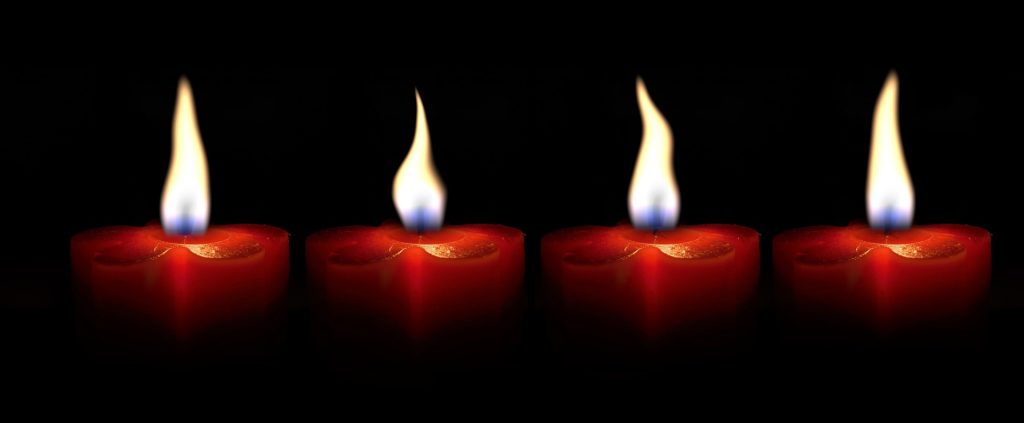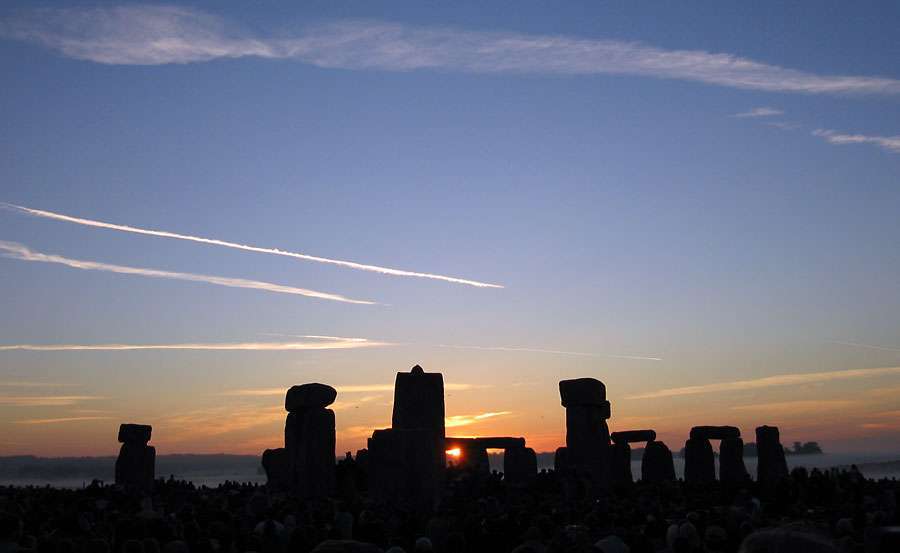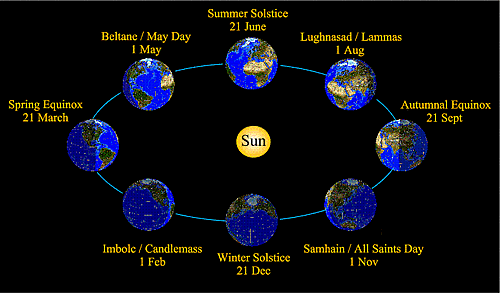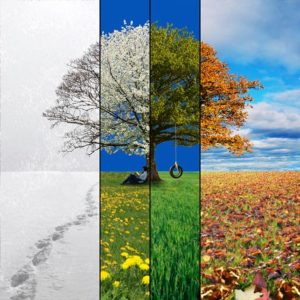
Expressing the powerful reliance and connection with nature
Our relationship with nature and the cycle of the seasons has long been a cause for celebrating in our communities. Important enough events for our ancestors to fix them in the cultural calendar. They expressed our community’s reliance on nature and our need to celebrate what was happening in the turning cycle of our year.
As we move through the seasons of the year and the turning cycle of nature there are 8 key points that occur when something is changing or beginning/ending. Four key points are linked to astronomical occurrences. Referred to as Solar Festivals. The remaining four intersperse them, linked to events in the farming (livestock) year. Referred to as Agricultural Festivals, or Cross-quarter days.
4 Solar Festivals (Celebrating the Seasons = Solstices & Equinoxes)
The four solar festivals occur on the two solstices; winter (the shortest day) and summer (the longest day). The two equinoxes (the days when day/night are equal) fall midway between the solstices. Astronomical occurrences were marked by our ancient ancestors. We know this from the alignment of their stone monuments.
The stone monuments of Stonehenge (Wiltshire, UK) and Newgrange (Ireland) were carefully constructed to align with both winter and summer solstices. Calanais (Callanish, Isle of Lewis), and Stenness (Orkney Isles) were not only constructed to align with the solstices, but also to align with the moon during a “major lunar standstill” (an event that happens once every 18.6 years (Higginbottom and Clay – Journal of Archaeological Science: Reports).
The research of Higginbottom and Clay showed that “the likelihood of the monuments being astronomical is above 97.87 percent for Stenness and 97.87 percent for Callanish”. They conclude “this is finally proof that the ancient Britons connected the Earth to the sky with their earliest standing stones, and that this practice continued in the same way for 2,000 years”.

During a major lunar standstill (the next one will occur in 2025), the moon moves through the sky at points that appear very high or very low on the horizon. It is unbelievable to suggest that our ancient ancestors; going to these lengths to mark astronomical occurrences, didn’t link them with some form of celebration. What form their celebration took we may never know.
The Arrival of Farming
Approximately 6,000 years ago farming arrived in Britain. Marking the beginning of the Neolithic period (New Stone Age) this transition had a profound effect upon our culture. Previously (the Mesolithic period and before), our ancestors were either hunter-fisher-gatherers or pastoralists (moving with their animals). Living ‘cheek by jowl’ with the natural world, lives and survival depended upon understanding nature and the turning wheel of the seasons in relation to farming practices.
Out of this came came customs and practices, rituals and superstitions. Undertakings to ensure that life progressed smoothly. That the Sun did return or the cattle were healthy. That lands and animals were fertile. Ensuring protection for houses and lives. That the Gods/Goddesses or other spirits of nature were happy and would look favourably on them. Some of these look downright weird to us today.

4 Agricultural Festivals (Celebrating the Seasons = Imbolc, Beltane, Lammas & Samhain)
Interspersed, more or less equally, between the solar festivals are the four agricultural festivals.
- Imbolc marks the very first signs of spring.
- Beltane marks the start of the summer and the cattle returning to the pastures.
- Lammas marks the first of the harvest.
- Samhain marks the last of the harvest and the beginning of the winter.
Celebrating the Seasons Throughout Changing Belief Systems
We know that our ancient ancestors marked the four solar festivals through the alignment of their stone monuments. We also know that the transition to farming created new beliefs & cultural practices. Many of these have influenced the traditions & cultural practices for celebrating the seasons that have been handed down through generations.
Since the arrival of farming the British Archipelago has undergone many more significant events that have had immense effects. The Roman invasion and the arrival of Christianity were two of the biggest.
The cultural effect of the Romans wasn’t as big as many people have been led to believe. The Romans had a pluralistic attitude to beliefs. They were quite happy to allow people to continue along their own paths; as long as they were not interfering with the Roman governance.
Christianity, on the other hand, took a different approach. Christianity ‘bolted on’ their own ‘story’ to the already existing celebrations. They christianised them. As they did with some of the ‘Old deities’ when they canonised them and turned them into saints. The celebrations, on the whole, remained firmly tied in with the ‘Agricultural Cycle’ until after the industrial revolution. Christianity also coined the term ‘pagan’. Using the Roman (Latin) term Paganus, which describes one who lives in a Pagus (a Roman rural district or community) and who follows the ‘Old Beliefs’ that are rooted in the land and locality.
In 1810 80% of the population lived in rural areas, by 1910 80% of the population lived in industrial urban areas. Industrialisation and urbanisation cut us off from nature and the land. It successfully detached us from being an intrinsic part of the cycle of the seasons. Detachment has caused us to lose the sense of identity and community that the celebration of these cycles brings.
Celebrating the Seasons Today
Seasons are still a part of our lives, our language and our culture. Whether we are rural or urban. Seasons bind us to nature and the passing of time. The seasons are a part of us; we still feel the ‘Joys of Spring’ or get the ‘Winter Blues. We can still note by the appearance of snowdrops or the trees starting to bud in the spring. The yellowing leaves or the last swallow flying show us that Autumn is upon us. We are not just a spectator sitting on the sidelines; we are bound to natural events.
Festivals and Celebrations are still there for us to take part in; MayDay, Apple Day, Harvest Festivals and many more still provide ways to connect with the landscape and local communities. These are our traditions, customs and practices and we need to keep them alive – after all we do not know what might happen if we don’t !!
Celebrating the seasons psychologically anchors us. It helps us move forward mindfully into the next season

Quick Links to the Seasons
Each celebration has its own page, on which you will find all the information relevant to it. Quick links below
For ideas on constructing your own celebration visit the relevant page – find out what it is all about, the history and beliefs surrounding it and the traditional customs & practices – select things that appeal to you and fit in with your lifestyle and put together your own unique version.
Traditional crafts are still practiced. They are worth learning and engaging with. After all who doesn’t like traditional willow baskets, or the idea of making their own corn dolly? If you fancy trying your hand at any of these you will find FREE downloadable instructions on our Traditional Craft Instructables page.